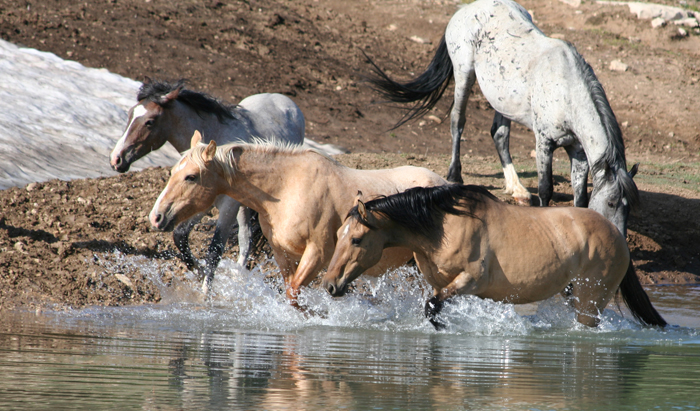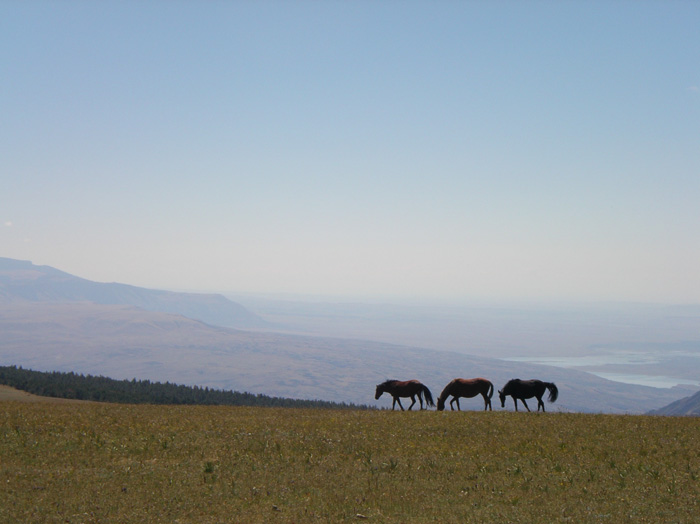This entry of the Pryor Mountain wild horses was contributed to Wild Equus Atlas by Dr. Jason Ransom of Colorado State University.
Species: Equus caballus
Subspecies/Breed/Type: American mustang
Country: United States of America
Region/Province/Range: Pryor Mountains – Montana
Population type: Semi feral – heavily managed
Estimated Population size: about 150 horses
Management Authority: Bureau of Land Management

Management Practices:
The US Bureau of Land Management has managed this population with periodic round-ups, adopting removed horses to the public. Horses from this population are highly adoptable because many of the animals exhibit genetic relatedness to more primitive Iberian horses and often have primitive markings such as a dorsal stripe, wither bars, and leg bars. Management began using the immunocontraceptive PZP in 2003, combined with periodic removals. Management today is done in partnership with the Pryor Mountain Mustang Center, a non-profit organization dedicated to the well-being of these horses.
For more information and a blog, please see the Pryor Mountain Mustang Center website at http://www.pryormustangs.org/
Details of Population
The Pryor Mountain Wild Horse Range, located in Bighorn County, Wyoming and Carbon County, Montana, USA (latitude 45°04‘N, longitude 108°19‘W), consists of roughly 16,000 ha of low desert, foothill slopes, forested montane slopes, steep canyons, and isolated grassy plateaus. Elevations ranged from 1,175 m to 2,670 m. Vegetation types varied greatly from lower to higher elevations of the range with lower elevations dominated by sagebrush communities, mid elevations dominated by curl-leaf mountain mahogany (Cercocarpus ledifolius) and Utah juniper communities, and high elevations dominated by limber pine (Pinus flexilis), subalpine fir (Abies lasiocarpa), and alpine bluegrass (Poa alpina). Mean annual precipitation is 161.4 mm (range = 96.7–233.4 mm) and mean annual temperature is 7.1°C (range -33.9– 40.0°C). Pumas (Puma concolor) prey on foals somewhat regularly, but rate of depredation varies over time as selected for by individual pumas. Most horses here tend to migrate to higher elevations in the summer as snow melts off of subalpine meadows and then they retreat into the mid-elevations and lower desert in winter. This area was protected for horses prior to the 1971 U.S. law that designated horse ranges thanks to grassroots public interest. That interest remains today and citizens continue to monitor horses and collaborate with researchers and managers toward the stewardship of this herd.

Structure and demographics
A detailed account of demographics from 1996-2003 can be found at: Demography of the Pryor Mountain Wild Horses
This report shows that pooled across years, productivity was 0.501 foals/mare (range = 0.254–0.705) for mares ≥2 years of age, 0.576 foals/mare (range = 0.300–0.795) for mares ≥3 years of age, and 0.597 foals/mare (range = 0.311–0.795) for mares ≥4 years of age. Pooled across years, ages, and sexes (n = 2,531), the annual survival rate of horses on the study area was 0.899.
Population size has ranged over the years from 200 horses, but averages closer to 150. The horses arrange themselves into 29 to 38 bands of 2–11 horses each. Bachelors form loosely associated ephemeral bands or range independently.

Issues worth noting and needed actions
Like most populations in the USA, available habitat for horses is finite and management is necessary to protect all natural resources while attempting to balance the multiple-use mandate for the federal lands where horses live. The science needed for more-informed management is improving, but many obstacles persist. You can read much more in the 2013 National Research Council report “Using Science to Improve the BLM Wild Horse and Burro Program: A Way Forward” Click link to view free PDF.
Bibliography and Further reading
On-going behavior and ecology research from Dr. Ransom can be followed on Twitter @wildequids
If you have further information or images you would like to share please contact us by email.
More entries to the Wild Equus Atlas;
Venezuelan Creoles WE – Entry from Dr. Jose Luis Canelon
Pottoka Piornal ponies WE – Entry from Lucy Ress
Pryor Mountain wild horses WE – Entry from Dr. Jason Ransom
McCullough Peaks horses – Entry from Dr. Jason Ransom
Aveto horses (WE) – Entry from Evelina Isola
Galician wild ponies WE – Entry from Dr. Laura Lagos
Namibia Desert horses WE – Entry from Dr. Telané Greyling
Delft Island horses WE – Entry from Wild Equus
Little Book Cliffs Wild Horses WE – Entry from Dr. Jason Ransom
Gower ponies WE – Entry from Jennie Nellist
Baguales WE – Entry from Dr. Victor Moraga and Enrique Zunzunegui
Exmoor Ponies WE – Entry from Sue McGeever
Tornquist feral horses WE – Entry from Dr. Alberto Scorolli
Sabucedo horses WE – Entry from Ivan Sanmartin Eirin
Cumberland Island horses WE – Entry from Wild Equus
Please share this initiative far and wide. Gracias!
This is an ongoing work, and as such, will be updated regularly as new information is made available.


